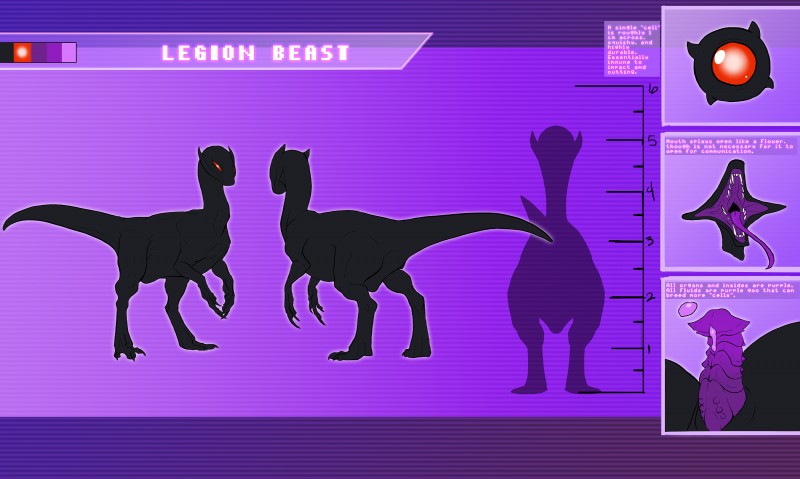Description
What IS a Legion Beast?
The Legion Beast is a most unique creature, in that each "creature" is, in fact, a multitude of single cell creatures bonded together to form a single body. Such bodies are often formed in shapes that are in ways beneficial to the group as a whole.
The single cells are roughly 1 cm across and sport a single eye. They are capable of self propelled areal movement by as yet unknown means. Each cell has a linked mind to the rest of the cells of a particular "beast", allowing them to learn and share experiences.
Communication, or speaking, is done by the cells vibrating at different pitches. More cells in tandem make this louder. While a single cell could make an audible sound, it would barely be above a whisper, generally requiring a group to be able to reach normal human talking volumes.
Cells are quite resilient, able to withstand intense pressures of the deep sea, though it's not known how they would function in a vacuum. Cells are mostly immune to cutting, the form often squishing out of the way of a blade. They are, however, not invulnerable. Cells can die if exposed to fire/intense heat for moderate periods of time and certain acids, such as those commonly found in the stomach, will destroy the cells.
A body formed by the cells emulates the creature it mimics, though with very little "need" for most organs, lacks many orifices normal creatures have, such as nasal, ear, or anal openings, leading to the peculiar head shape. This is to discourage parasites from attempting to assault it. While a parasite wouldn't be able to properly gain nourishment from a Legion Beast, and the cells on the skin layer of the body could attack said parasite, a LB generally prefers to avoid the chance altogether.
That said, a LB gains sustenance through hunting and foraging; choosing a form best adapted for the environment. It will perform the act of eating like said creature where the food is passed to a stomach area where cells carefully bathe it in their membranes, slowly absorbing it into the system before propagating the purple fluid.
The purple fluid is the lifeblood of a LB. It is how cells bond, how they share nutrients to other cells, and also contains the basics to form new cells.
Reproduction of LB is performed in several ways. The cells do not divide, therefore mitosis is not one of them. If food is somewhat scarce, a LB will take the role of a male of the species it is mimicking. It will establish a territory and will court a female of the species it is similar to. After courting is performed and mating is possible, the LB will generate a phallus and mate the female. Climax does resonate as pleasure in the LB, though the "ejaculate" is more of the purple fluid. The fluid is highly nutritious and will often see the female gain more energy, though it will begin showing signs of pregnancy. Internally, the purple fluid will be propagating more cells, however, these cells will not be mentally linked to the primary mass. The cells will do no harm to the mother and will form a black, gelatinous egg that will be passed out, regardless of what the mother species is, but the size of the mother will determine the size of the egg. The "egg" will then scatter into a cloud of cells that scan the environment for a form that is in abundance, though often this will be in the form of the mother creature. They then take on that form and will play the part of a dependent offspring.
If food is in abundance, a LB will often live a solitary existence and will propagate via creating a "womb" where it will dump excess purple fluid and grow more cells. These cells can be ejected to become a new LB swarm, or integrated into the body to increase the mass, much like growing.
A LB is capable of taking on a female role as well, though this is generally if a swarm is somewhat on the verge of starving. It will play the role of a fairly submissive female who is quite frequently hungry and then permit the male to mount a created vaginal cavity when he attempts to mate. The ejaculate is broken down into purple fluid along with the food that is brought by the male to feed the starving cells. To keep up the act, a female LB, when properly fed, will produce additional cell groups in the form of the same species, though after the male departs, the smaller LB groups will swarm off to scout for new, more beneficial forms for the area.
What is most important to keep in mind is that a LB is intelligent. Despite a single one being comprised of single cells, all the cells share the same memory and learn at fairly impressive rates. They express emotions and frequently become bonded to other beings and are not innately malicious, though harsh living conditions can leave one predisposed to attacking before they are attacked.
So what are you waiting for? Make yourself a friend!

Daneasaur
MemberOnce again, e621 insists on largest size possible, so I provide.
Login to respond »